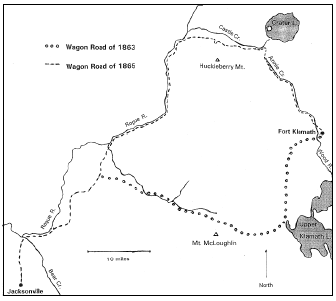The Botanists at Crater Lake National Park by Elizabeth L. Horn
Kalmiopsis Volume 12, 2005 31
***previous*** — ***next***
Early Exploration and Discoveries of New Species
Steel also invited a party from the Department of Agriculture, including Dr. Frederick V. Coville, Chief Botanist, and John B. Leiberg, who were investigating the plains vegetation of southeastern Oregon at the time. They reached the Crater Lake rim on August 13 from Fort Klamath via Anna (Annie) Creek (Coville 1897). Other members of this group were Dr. C. Hart Merriam, Chief of the U.S. Biological Survey, and his assistants Vernon Bailey, Edward Prebble, and Cleveland Allen (Applegate 1939). Merriam was working on his Life Zone classifications, which were later widely used throughout the mountainous West. Elmer I. Applegate, who had been corresponding with Coville, also joined the Crater Lake expedition (Lang 2003).
 Map of wagon road route to Crater Lake in 1865. Map by Steve Mark, Crater Lake National Park.
Map of wagon road route to Crater Lake in 1865. Map by Steve Mark, Crater Lake National Park.
Coville’s party camped on the rim of Crater Lake for a week, collecting plants from Llao Rock, the Watchman, Castle Crest, and Mount Scott as well as from Pole Bridge Creek, Vidae Cliff, and Red Cone. Coville even descended the trail down the caldera wall to a boat landing and visited Wizard Island (Coville 1897). Applegate and his brother Fred explored Mount Scott and provided Coville with a list of 22 specimens collected on the summit as well as additional species from the southern flank. Coville also received specimens from Mazama member/Oregon botanist Martin W. Gorman, who had made collecting trips to Crater Lake in the 1880s and again in 1896 (Bornholdt, pers. comm.).
“The August Vegetation of Mount Mazama” (Coville 1897) included 175 species, five of which were newly described: pumice sandwort (Arenaria pumicola), Mount Mazama collomia (Collomia mazama), Gorman’s buttercup (Ranunculus gormanii), Crater Lake currant (Ribes erythrocarpum), and grouseberry (Vaccinium scoparium) (Zika 2003). This doesn’t count the paintbrush that Applegate collected on Mount Scott, which was originally identified as Castilleja parviflora, but was later named C. applegatei by M. L. Fernald of Harvard (Lang 2003).
Coville’s description reveals that generally, the vegetation has changed little since 1897:
“The vegetation about Crater Lake is primarily a great coniferous forest. Most of the mountain slopes are covered by a dense growth of trees….The forests are rather dry and have almost no underbrush, not enough to impede a foot-traveler. The commonest shrub is Ribes erythrocarpum and the most abundant plant Juncus glabratum [Luzula hitchcockii]…. On the gentle outer slopes of the crater occur long stretches of open land entirely devoid of trees and evidently covered until late in the spring with snow.”
What has changed is public access and botanical collection. In the 1890s, botanical collection at Crater Lake was difficult: it took three days by wagon or horseback to travel from Ashland or Jacksonville, and about the same amount of time from Linkville [Klamath Falls] (Applegate 1939), via an 1865 military road that the Army built to carry supplies from the Rogue Valley to its post at Fort Klamath. This road followed much the same route as present day Highway 62, staying above and south of Annie Creek and Castle Creek Canyons. From the military road, a tourist group from Jacksonville blazed a two-mile track from the Army road up Dutton Creek to the rim of Crater Lake (Mark 1997). After national park status was achieved in 1902, road improvements followed, as did the botanists. Now over 500,000 people visit the park every year, and plant collection may only be done by permit.
***previous*** — ***next***

